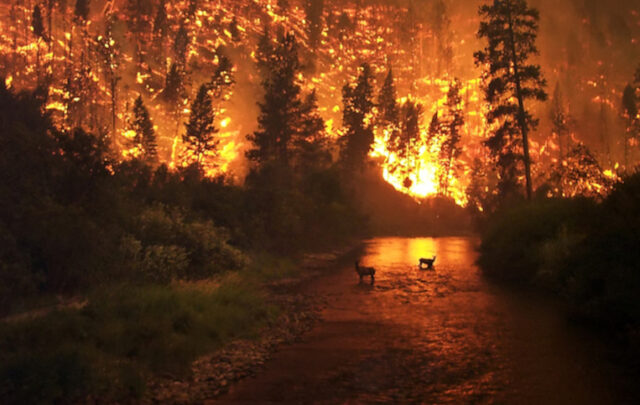Click on the headline (link) for the full text.
Many more articles are available through the Energy Bulletin homepage
“Asian Brown Cloud” is speeding melt of Himalaya glaciers: study
Richard Ingham, AFP
The haze of pollution that blankets southern Asia is accelerating the loss of Himalayan glaciers, bequeathing an incalculable bill to China, India and other countries whose rivers flow from this source, scientists warned on Wednesday.
In a study released by the British journal Nature, the investigators say the so-called Asian Brown Cloud is as much to blame as greenhouse gases for the warming observed in the Himalayas over the past half century.
Rapid melting among the 46,000 glaciers on the Tibetan Plateau, the third-largest ice mass on the planet, is already causing downstream flooding late summer. But long-term worries focus more on the danger of drought, as the glaciers shrink.
(1 August 2007)
‘Siberian forest fires due to climate change’
Roger Highfield, Telegraph (UK)
Devastating forest fires in Siberia that send a pall of smoke worldwide are happening more frequently because of climate change and in turn accelerating the pace of global warming, scientists claim.
In Central Siberia alone fires destroyed 15,000 square miles in 2003, triggering plumes which were linked with air pollution measured as far away as America. The forest fires send as much greenhouse gas into the atmosphere as the total EU reduction commitment under the Kyoto protocol.
In the Journal of Climate, an international team concludes that Siberian fires are influenced by climate change. The study was led by the Professor Heiko Balzter of the Department of Geography at the University of Leicester.
advertisement
(1 August 2007)
Pakistan: Uncontrolled Population Blamed for Climate Change
Zofeen Ebrahim, IPS
KARACHI – When it comes to climate change population matters, particularly for countries in South Asia, Africa and some Arab countries, says Prof. Khalid Rashid. A mathematician and physicist in Pakistan, he has long been studying the phenomenon of global warming and views the uncontrolled population explosion with much trepidation.
But there are climate scientists like Dr Shaheen Rafi Khan, a researcher with an Islamabad-based policy-oriented research institute, the Sustainable Development Policy Institute (SDPI), who insist it is how we live and use resources that matters not the number of people.
“Because,” insists Dr Khan, “the focus remains on emissions in the North and adaptation to climate change in the South. The South is the victim of climate change not the agent.”
He however, adds: “Population growth impact is likely to be incremental and the country that will contribute substantively to it will be India, with its large and growing population and surging economic growth.”
As people struggle to survive in poor countries, environmental degradation is more pervasive. Long-term sustainable development goals are disregarded in favour of immediate subsistence needs. Increased use of wood for fuel, abusive use of land and water resources, in the form of overgrazing, over fishing, depletion of fresh water and desertification – are common in poor countries.
In Asia, in particular, another cause for concern is the rapid industrialisation of India and China. This means fossil fuel consumption has increased.
“Deep down human population is the main cause. If the world population would stay around 100 million, this population could afford an energy-intensive, yet sustainable, lifestyle. The effect on the planet would be small,” says Prof. Rashid.
(31 July 2007)
It doesn’t seem to be worthwhile to argue whether the root cause is population or consumption level. Both are factors in an ongoing dynamic. -BA





